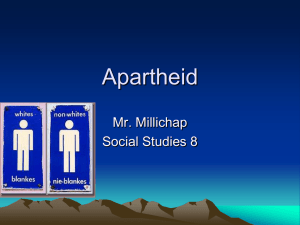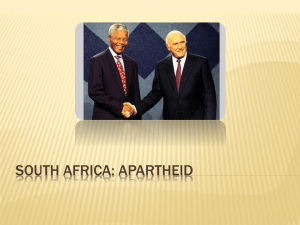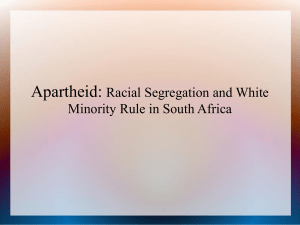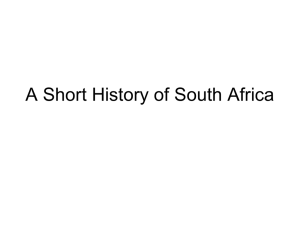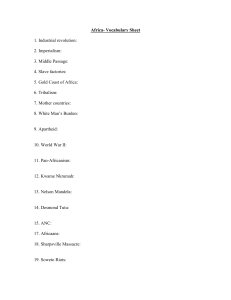National resistance to apartheid notes
advertisement
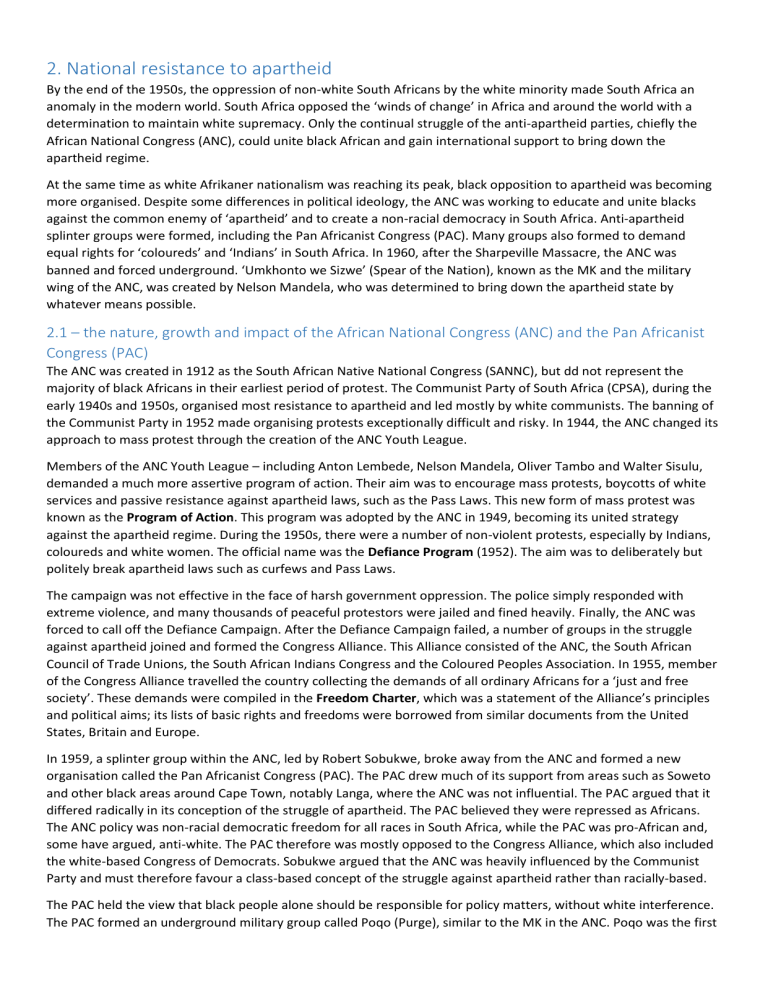
2. National resistance to apartheid By the end of the 1950s, the oppression of non-white South Africans by the white minority made South Africa an anomaly in the modern world. South Africa opposed the ‘winds of change’ in Africa and around the world with a determination to maintain white supremacy. Only the continual struggle of the anti-apartheid parties, chiefly the African National Congress (ANC), could unite black African and gain international support to bring down the apartheid regime. At the same time as white Afrikaner nationalism was reaching its peak, black opposition to apartheid was becoming more organised. Despite some differences in political ideology, the ANC was working to educate and unite blacks against the common enemy of ‘apartheid’ and to create a non-racial democracy in South Africa. Anti-apartheid splinter groups were formed, including the Pan Africanist Congress (PAC). Many groups also formed to demand equal rights for ‘coloureds’ and ‘Indians’ in South Africa. In 1960, after the Sharpeville Massacre, the ANC was banned and forced underground. ‘Umkhonto we Sizwe’ (Spear of the Nation), known as the MK and the military wing of the ANC, was created by Nelson Mandela, who was determined to bring down the apartheid state by whatever means possible. 2.1 – the nature, growth and impact of the African National Congress (ANC) and the Pan Africanist Congress (PAC) The ANC was created in 1912 as the South African Native National Congress (SANNC), but dd not represent the majority of black Africans in their earliest period of protest. The Communist Party of South Africa (CPSA), during the early 1940s and 1950s, organised most resistance to apartheid and led mostly by white communists. The banning of the Communist Party in 1952 made organising protests exceptionally difficult and risky. In 1944, the ANC changed its approach to mass protest through the creation of the ANC Youth League. Members of the ANC Youth League – including Anton Lembede, Nelson Mandela, Oliver Tambo and Walter Sisulu, demanded a much more assertive program of action. Their aim was to encourage mass protests, boycotts of white services and passive resistance against apartheid laws, such as the Pass Laws. This new form of mass protest was known as the Program of Action. This program was adopted by the ANC in 1949, becoming its united strategy against the apartheid regime. During the 1950s, there were a number of non-violent protests, especially by Indians, coloureds and white women. The official name was the Defiance Program (1952). The aim was to deliberately but politely break apartheid laws such as curfews and Pass Laws. The campaign was not effective in the face of harsh government oppression. The police simply responded with extreme violence, and many thousands of peaceful protestors were jailed and fined heavily. Finally, the ANC was forced to call off the Defiance Campaign. After the Defiance Campaign failed, a number of groups in the struggle against apartheid joined and formed the Congress Alliance. This Alliance consisted of the ANC, the South African Council of Trade Unions, the South African Indians Congress and the Coloured Peoples Association. In 1955, member of the Congress Alliance travelled the country collecting the demands of all ordinary Africans for a ‘just and free society’. These demands were compiled in the Freedom Charter, which was a statement of the Alliance’s principles and political aims; its lists of basic rights and freedoms were borrowed from similar documents from the United States, Britain and Europe. In 1959, a splinter group within the ANC, led by Robert Sobukwe, broke away from the ANC and formed a new organisation called the Pan Africanist Congress (PAC). The PAC drew much of its support from areas such as Soweto and other black areas around Cape Town, notably Langa, where the ANC was not influential. The PAC argued that it differed radically in its conception of the struggle of apartheid. The PAC believed they were repressed as Africans. The ANC policy was non-racial democratic freedom for all races in South Africa, while the PAC was pro-African and, some have argued, anti-white. The PAC therefore was mostly opposed to the Congress Alliance, which also included the white-based Congress of Democrats. Sobukwe argued that the ANC was heavily influenced by the Communist Party and must therefore favour a class-based concept of the struggle against apartheid rather than racially-based. The PAC held the view that black people alone should be responsible for policy matters, without white interference. The PAC formed an underground military group called Poqo (Purge), similar to the MK in the ANC. Poqo was the first black political organisation in South Africa that openly accepted the taking of human life as part of its strategy, and some historians have argued that it was far more militant that the ANC. Questions: 1. 2. 3. 4. Outline the ANC. What was their vision for South Africa? Explain the aim of the Defiance Campaign. Outline the PAC. What was their vision for South Africa? Explain what Poqo was and what they stood for. 2.2 – significance of the Sharpeville massacre On 21 March 1960, the PAC organised a protest against the Pass Laws. The campaign involved large numbers of protestors marching to the police station in Sharpeville, where they would burn their passes in protest. Over 5000 protestors converged on the tiny police station, armed at most with stones. The police inside opened fire and killed 69 protestors (of these, eight women and ten children were shot in the back while running away). The police also wounded another 180. At the same time in the Langa Township near Cape Town, the PAC was also demonstrating and some 20, 000 protestors were gathered. The protestors were baton-charged and ordered to leave. They threw stones and the police opened fire, killing two and wounding 49 protestors. The consequences of the shootings at both Sharpeville and Langa were immediate: South Africa received international condemnation and calls for apartheid to end. Trouble erupted in Cape Town when Phillip Kgosana, the local PAC leader, led 30,000 protestors to the House of Parliament to protest police violence. The police did not have the numbers to hold back the protestors and a compromise was reached where Pass Laws were suspended. The following day, however, Kgosana was arrested and the suspension order lifted. The vulnerability of white South Africa and the seething undercurrent of black unrest were made very clear to the South African government and to the world. Both the ANC and PAC were banned and immediately went underground, and some members went into exile. Going forward, both MK and Poqo changed direction from non-violent protests to direct military action against the apartheid regime. PAC president Robert Sobukwe and other leaders were arrested. Nelson Mandela and Oliver Tambo of the ANC fled overseas. The UN Security Council passed Resolution 134 in response to address the issues of the shooting 2.3 – Mandela as the head of Umkhonto we Sizwe, ‘The Spear of the Nation’ (MK) After the Sharpeville Massacre, the ANC was banned by the government, but it continued its activities underground. Nelson Mandela pushed the ANC and its military unit, MK, towards the direction of sabotage. MK’s sabotage attacks in 1961 were against power stations and other strategic government buildings and symbols of apartheid, such as the Department of Bantu Administration and Development. The banning of the ANC left it no option but to pursue a policy of violence. It was obvious to Mandela and many others in the ANC executive that decades of non-violent resistance had only led to harsher repression by the white government. The objective of sabotage was to harm the white economy, and bring national and international attention to the ANC cause. After its banning, Mandela and the MK successfully operated underground for almost 2 years. In this time Mandela moved covertly across South Africa and trained in Ethiopia with other MK members as a guerrilla fighter. He had close encounters with police in South Africa to the point where he had to disguise as a chauffeur, gardener, milkman and chef in order to successfully dodge the police. He also made his way to Britain and other African states, seeking support and advice on fighting the apartheid regime. Is most important work, however, was leading the MK, and keeping newspapers informed of its political aims and of the next sabotage attacks. However, in August 1962, Mandela was arrested in Natal and received a three-year sentence for incitement. 2.4 – Rivonia Trial, imprisonment and Robben Island, ‘Free Mandela’ campaign The activities of Nelson Mandela and Umkhonto we Sizwe (MK) came to a sudden halt when the police arrested MK’s executive, including Walter Sisulu, at a hideout on Lilliesleaf farm in Rivonia, Johannesburg. The police found evidence that MK was planning a large-scale military action code-named Operation Mayibuye (meaning ‘bringing back what was lost’) … The white state was thrown overboard every pretence of rule by democratic process. Armed to the teeth it has presented the people with only one choice and that is its overthrow by force and violence. It can now truly be said that very little, if any, scope exists for the smashing of white supremacy other than by means of mass revolutionary action, the main content of shich is armed resistance leading to victory by military means… Extract of MK planning document for Operation Mayibuye found by the police at Rivonia, 11 July 1963 Members of the ANC and whites in the South African Communist Party were arrested and charged with treason against South Africa. They were all charged with sabotage, Mandela being brought from prison to stand trial with them. The white government was outraged that a banned organisation was planning a black revolution. The involvement of the Communist Party was made the central issue in the persecution of the MK leaders. In the context of the Cold War and decolonisation in other African states, the government was determined to see the ‘traitors and terrorists’ executed for violence against white society. The Rivonia Trial and the life sentences of ANC leaders broke not only the leadership of MK but to some extent it immediate spirit of resistance. The role of Nelson Mandela during the trial was highly significant in recharging the spirit of resistance. Mandela, a trained and articulate lawyer, used the trial as a platform to respond to the oppression by white society in South Africa. During the trial, Nelson Mandela made a historic address to the white members of the court. Firstly, he explained the ANC’s decision to adopt violent strategies. “Four forms of violence were possible. There is sabotage, there is guerrilla warfare, there is terrorism, and there is open revolution. We chose to adopt the first method and to exhaust it before taking any other decision. In the light of our political background the choice was a logical one. Sabotage did not involve loss of life, and it offered the best hope for future race relations. Bitterness would be kept to a minimum and, if the policy bore fruit, democratic government could become a reality… The initial plan was based on a careful analysis of the political and economic situation of our country. We believed that South Africa depended to a large extent on foreign capital and foreign trade. We felt that planned destruction of power plants, and interference with rail and telephone communications, would tend to scare away capital from the country, make it more difficult for goods from the industrial areas to reach the seaports on schedule, and would in the long run be a heavy drain on the economic life of the country, thus compelling the voters of the country to reconsider their position… This then was the plan. Umkhonto was to perform sabotage, and strict instructions were given to its members right from the start, that on no account were they to injure or kill people in planning or carrying out operations… During my lifetime I have dedicated myself to this struggle of the African people. I have fought against white domination, and I have fought against black domination. I have cherished the ideal of a democratic and free society in which all persons live together in harmony and with equal opportunities. It is an ideal which I hope to live for and to achieve. But if needs be, it is an ideal for which I am prepared to die.” SOURCE QUESTIONS 1. 2. 3. 4. List the four violent options open to the ANC. According to the source, how did Mandela justify choosing sabotage? According to the source, what was Umkhonto we Sizwe hoping that sabotage would achieve? Using your own knowledge, explain how the Sharpeville Massacre motivate the ANC to change its approach to fighting against apartheid. 5. Explain the strengths and weaknesses of Mandela’s point of view. The members of the ANC, including Nelson Mandela, Walter Sisulu and Govan Mbeki were found guilty. Fortunately, the world’s attention was on the Rivonia Trial, and the death penalty was begrudgingly withdrawn by the government. The accused were found guilty and sentence to life in prison on Robben Island, a small desolate island off Cape Town. The course of Nelson Mandela to defy white law under the threat of death and to make a stand on universally moral grounds elevated the ‘struggle’ of black South Africans and their representatives in the ANC. Mandela gained a high international profile and became the focus point and international figurehead in anti-apartheid protests then and for years to come. 2.6 – significance of Stephen Biko and the Black Consciousness Movement The banning of the ANC and the PAC left a political vacuum in black politics in South Africa during the 1960s. This void was filled by the Black Consciousness Movement (BCM). BCM was led by Stephen Biko, a young medical student at the University at the University of Natal. Biko was a powerful writer and was able to expound the intellectual theories of Black Consciousness coming out of the United States and apply them to the struggle against apartheid. Biko formed the South African Students Organisation (SASO), a breakaway group from the National Union of Students, which demanded change and argued that whites in South Arica would not take the necessary steps to end apartheid, declaring only pride in black culture and history and an advancement of black consciousness could end apartheid. Biko expressed the theory of Black Consciousness in SASO newsletters entitled ‘I Write What I Like’. He argued that only black people could liberate themselves from their social and economic dependence on white society as whites were too entrenched in apartheid. In order to advance black consciousness and reach more black people, Biko and other university students set up Community Health Clinics, such as the Zanempilo Community Health Care Centre, to give free medicine and treatment to those in need. This work and his public criticism of white oppression gained him national and international attention, and as a result, the apartheid regime had Biko banned in 1973. From 1973 onwards, Biko was under close scrutiny by South African Police. In 1977, he was arrested once again and held naked in a cell for 18 days. He was interrogated and beaten into a coma. Biko lay dying from internal bleeding and head wounds, and was driven over 1000kms from his King William’s Town cell to a Pretoria Army Hospital where he was pronounced dead on arrival. His death was listed as an accident by prison officials. The BCM was immediately banned by the government and the Community Health Clinics Biko created were destroyed by police.
